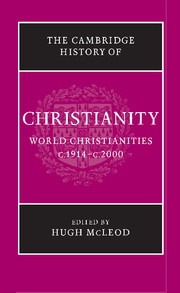Book contents
- Frontmatter
- 1 Introduction
- 2 Being a Christian in the early twentieth century
- PART I INSTITUTIONS AND MOVEMENTS
- PART II NARRATIVES OF CHANGE
- 8 The Great War
- 9 The Christian churches and politics in Europe, 1914–1939
- 10 Latin America, c.1914–c.1950
- 11 African Christianity: from the world wars to decolonisation
- 12 The African diaspora in the Caribbean and Europe from pre-emancipation to the present day
- 13 Christianity in the United States during the inter-war years
- 14 Christian churches in Australia, New Zealand and the Pacific, 1914–1970
- 15 Catholicism and Protestantism in the Second World War in Europe
- 16 The Cold War, the hegemony of the United States and the golden age of Christian democracy
- 17 The religious ferment of the sixties
- 18 The crisis of Christianity in the West: etering a post-Christian era?
- 19 The revolutions in eastern Europe and the beginnings of the post-communist era
- 20 The transformation of Latin American Christianity, c.1950–2000
- 21 Religion and racism: struggles around segregation, ‘Jim Crow’ and apartheid
- 22 Post-colonial Christianity in Africa
- 23 South Asia, 1911–2003
- 24 Christianity in South-East Asia, 1914–2000
- 25 East Asia
- PART III SOCIAL AND CULTURAL IMPACT
- Bibliography
- Index
- References
25 - East Asia
from PART II - NARRATIVES OF CHANGE
Published online by Cambridge University Press: 28 March 2008
- Frontmatter
- 1 Introduction
- 2 Being a Christian in the early twentieth century
- PART I INSTITUTIONS AND MOVEMENTS
- PART II NARRATIVES OF CHANGE
- 8 The Great War
- 9 The Christian churches and politics in Europe, 1914–1939
- 10 Latin America, c.1914–c.1950
- 11 African Christianity: from the world wars to decolonisation
- 12 The African diaspora in the Caribbean and Europe from pre-emancipation to the present day
- 13 Christianity in the United States during the inter-war years
- 14 Christian churches in Australia, New Zealand and the Pacific, 1914–1970
- 15 Catholicism and Protestantism in the Second World War in Europe
- 16 The Cold War, the hegemony of the United States and the golden age of Christian democracy
- 17 The religious ferment of the sixties
- 18 The crisis of Christianity in the West: etering a post-Christian era?
- 19 The revolutions in eastern Europe and the beginnings of the post-communist era
- 20 The transformation of Latin American Christianity, c.1950–2000
- 21 Religion and racism: struggles around segregation, ‘Jim Crow’ and apartheid
- 22 Post-colonial Christianity in Africa
- 23 South Asia, 1911–2003
- 24 Christianity in South-East Asia, 1914–2000
- 25 East Asia
- PART III SOCIAL AND CULTURAL IMPACT
- Bibliography
- Index
- References
Summary
Some two-thirds of the way into A history of Christian missions in China, Yale historian Kenneth Scott Latourette’s great opus of 1929, a work of massive erudition, readers are invited to join the author in a mind’s-eye tour of the Christian educational institutions flourishing in China on the eve of World War I. Latourette starts in the south at Canton (Guangzhou) with Lingnan university, an American Presbyterian institution, and works his way to the north, ending with Shantung (Shandong) Christian university in Tsinan (Jinan), a venture involving American and Canadian Presbyterians, English Baptists and Anglicans. Had Latourette been looking ahead to the 1920s, the premier institution of all, Yenching (Yanjing) university in Peking (Beijing), an even bolder ecumenical, multi-national endeavour, could have been included. Latourette’s reverie takes up eight pages; as founders are eulogised, expenditures noted, and graduates enumerated, considerable pride is evinced. Christian institutions, in Latourette’s view, were the accelerators of far-reaching changes already occurring as the Qing dynasty (1644–1912) receded into antiquity and the ‘new’ China of the Republican era (1912–49) dawned.
Latourette stops with China; had he gone beyond it to Japan and Korea in 1914, readers would have been treated to a similar panoply of missionary institutions. Japan, two years into the Taisho era (1912–25), had been ushered out of isolation into the frenzy of modernisation in the Meiji era (1868–1912) by networks of Christian schools stretching from Hokkaido to Honshu to Kyushu. Korea, too, already under Japanese occupation (1910), had its own extensive array of missionary institutions, from P’yongyang to Seoul, founded in the final years of the tottering Choson dynasty (1598–1910).
- Type
- Chapter
- Information
- The Cambridge History of Christianity , pp. 450 - 468Publisher: Cambridge University PressPrint publication year: 2006

